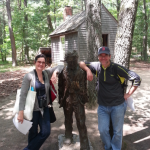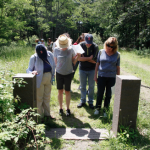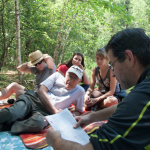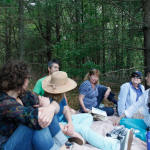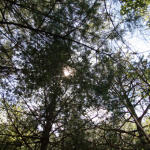Walking Walden to Brister’s Hill
- Wen Stephenson and I with Henry
- walking down the path to Thoreau’s house site
- looking at the entrance stone to Brister’s Hill path at Walden Woods
- Wen reading from his late Mat essay in The Nation
- Nathan Phillips (behind the hat) talking about a fossil free diet
- treetops
Yesterday Wen Stephenson and I led a walking event taking a group of people from in front of the Thoreau House replica at Walden Pond, through the woods to the original Thoreau house site, and on to Brister’s Hill, where we spread out picnic blankets in the shade, listened to Wen read excerpts from his Nation essay and discussed what we thought radical looks like to each of us.
Here is a transcript of my introduction:
Choose two readers from the group to call and response style read this text:
June 13, 1858 / June 13, 2013
Thoreau’s journal / Google News
Kalmiana lily several days
The Fracking Story Comes Closer to Home
the little gallium in meadow say 1 day
Starved for Arms, Syria Rebels Make Their Own
A song sparrow’s nest in a ditch
NSA Chief Says Phone Logs Halted Terror
Vib dentatum ap not long – say two days
Global Shares Fall for a 3rd Day Straight
A cherry bird’s nest and 2 eggs in an apple tree
Bloomberg Plan to Save New York from Climate Change
It suddenly began to rain with great violence
June, July, and August, the tortoise eggs are hatching a few inches beneath the surface in sandy fields. You tell of active labors, of works of art, and wars the past summer; meanwhile the tortoise eggs underlie this turmoil…Sumner knocked down; Kansas living an age of suspense…French empires rise or fall, but the turtle is developed only so fast. What’s a summer? Time for a turtle’s eggs to hatch.
Thoreau’s journal: August 28, 1856
(thanks to David Wood for sending me this)
I am an artist, educator, mother, sometime writer and curator, and emerging activist. I currently have a project at the deCordova: Field Station Concordia, which takes the form of a field station created from reclaimed materials in the dimensions of Thoreau’s cabin at Walden. It functions as a platform for the gathering of data about the local ecology in the form of observations, handmade and virtual representations, and texts and maps that challenge and reimagine the separation of human and natural agency. Activities include: data collection, community gatherings, citizen science, handmade and digital explorations of plant and animal life, and questions about the vibrancy of matter and our role in the stresses and resiliences of ecosystems. The project seeks to activate individuals to engage in participatory ecology in a desire to activate our connection to this vague thing we have called “nature” with political,
social and economic meaning and weight. The project uses embodied engaged observation to map a civic engagement with our backyards as part of the larger ecosystem of towns, industries, politics, and economies.
The project is guided by the radical environmentalism of Thoreau, who saw himself politically, spiritually, economically, and socially as one active agent in a community of active agents. Thoreau’s lifetime of observations in the form of the Kalendar (as he called it, a seasonally organized collection of his observations of weather, plant phonological phases, birds, mushrooms, lichen, etc.), journal and published reflections, and surveying (as a constant walker of the land and as a paid surveyor) are the inspiration and the call to us from 150 years ago at the beginning of the industrial age and our messing up nature.
Invited Wen why:
Read his bio
Two years ago Wen posted on Slate.com a series of ruminations on Thoreau, climate change, community, and engagement that inspired me to call him and initiate this conversation today and I quote from a part of it:
I began writing this essay in October 2010. At some point along the way I asked myself, why only walk to Walden and back? Why not walk in every direction from my house, “hear the cock crow in every barn-yard within my horizon,” as Thoreau would have it? Why not take him up on his challenge, really live in the present? Not merely in some private endeavor to connect spiritually with nature—but to connect with nature, yes, and with my fellow human beings who inhabit my surrounding landscape. I’ve lived in New England for 20 years, and Wayland for 14, but like many rootless Americans I’ve found that I’m a tourist in my own town, my own place, and a stranger to my neighbors. And so I’ve set out to become a full inhabitant, to make this place my home. To find community, human and wild. Right here in suburbia. Because we’re all in this together. That’s the truth we’re going to learn in the difficult decades ahead. And that’s what we have to teach our children—because they’re going to need the resources of community, and the strength that resides in it, even more than we do.
So, we are going to walk from here, Thoreau’s home to Brister’s Hill.
Brister Freeman was as they say in the history books abandoned to freedom, meaning his slave owner had no real intention of releasing him to full rights of citizenship, but instead a partial and obscure status of abandonment and marginal existence. Brister served in the army and through a series of name changes ended up naming himself Freeman. He was one of the only former slaves to own land in his own right in Concord, which he fought to purchase and maintain throughout his life. He bought land right across route 2, land that was at the time considered poor agricultural land and which was in the midst of other former slave homes, including his sister Zilpah White, who squatted across the street from here for her whole life earning a living from spinning.
So we will walk from the heart of American’s concept of what nature is to a site which is at the heart of our very complex and troubled history of slave ownership and economic freedom, of abolitionist support and radical politics. Wen will speak more about his recent writings on these topics as we get to Brister’s Hill.
SO we are going to walk through some of the Walden Paths to Route 2, which should take about ten minutes. We’ll pass near the site of Thoreau’s house and beanfields. Lets walk in silence. Lets contemplate these questions:
What do we know about the ecology we are walking through?
What don’t we know?
What is our conception of “nature?” What is missing from or outside of our conception of “Nature”?
What does a radical engagement with the changes happening in our
environment look like us as individuals and communities?
